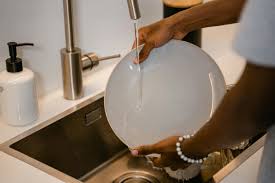Call us: 0414 493 412
Maintaining a clean kitchen is essential for the health and safety of everyone who enjoys the meals prepared there. Here, we’ll walk you through the essential steps to keep your kitchen tools spotless and safe, all while sounding just like me!
Cleaning Utensils
First things first, let’s start with the utensils. Gather your spoons, forks, knives, spatulas, colanders, cups, plates, bowls, and similar items, and get them ready for washing.
1. Preparation
- Wear Washing Gloves: Protect those hands and make cleaning more comfortable by putting on washing gloves.
- Remove Food Debris: Scrape off any leftover food or debris from the utensils. We’re talking spoons, forks, knives, colanders, cups, plates, bowls, and similar items here.
2. Soaking
- Fill the Sink: Fill the sink or basin with warm water (not hot) to avoid burning yourself.
- Use Eco-Friendly Dishwashing Liquid: Make sure you use an eco-friendly dishwashing liquid. Some people may be sensitive to dishwashing liquids due to medical conditions or treatments.
- Soak Utensils: Soak the utensils for around 15 minutes to loosen any stubborn food particles.
3. Scrubbing
- Use a Sponge or Brush: Scrub the utensils thoroughly with a sponge or brush, making sure you clean every side, corner, and part of the utensils.
4. Rinsing
- Rinse with Warm Water: Rinse the utensils with warm water (not hot) to ensure all soap residue is removed. Safety first!
- Drying: Place the utensils on a dish rack or environmentally friendly multiple-layer folded paper towel. Ensure there is no dishwashing liquid left on the utensils.
Cleaning Food Equipment
Food equipment such as pots, pans, blenders, and cutting boards also need proper cleaning. Here’s how to do it effectively:
1. Preparation
- Disassemble: Disassemble any equipment that has removable parts, such as blenders and food processors.
- Remove Food Debris: Scrape off any leftover food from the equipment.
2. Soaking
- Fill the Sink: Fill the sink or basin with warm water and add eco-friendly dishwashing liquid.
- Soak Equipment: Soak the equipment for 15-20 minutes to loosen any stubborn food particles.
3. Scrubbing
- Use a Brush or Sponge: Scrub the equipment thoroughly, paying special attention to any hard-to-reach areas and removable parts.
4. Rinsing
- Rinse with Warm Water: Rinse the equipment with warm water to remove all soap residue. People with medical conditions can be sensitive to dishwashing liquid residue, so it’s crucial to ensure there’s no residue left.
- Drying: Place the equipment on a dish rack or towel to dry completely before reassembling.
Why Cleanliness Matters
It’s important to note that some people with medical conditions can be particularly sensitive to dishwashing liquid residue. This can cause discomfort and irritation, making it essential to ensure that no residue is left on the utensils and equipment after cleaning.
Cleanliness is a crucial step in preventing foodborne illnesses. Many people, unfortunately, learn the hard way why cleanliness is essential. If you don’t enjoy cleaning, try putting on some music to entertain yourself and dance while you clean. It can make the task more enjoyable.
By following these steps, you’ll ensure that your kitchen utensils and equipment are clean, safe, and ready for use, keeping you and your loved ones healthy.
Happy cleaning! 🎶🧽
